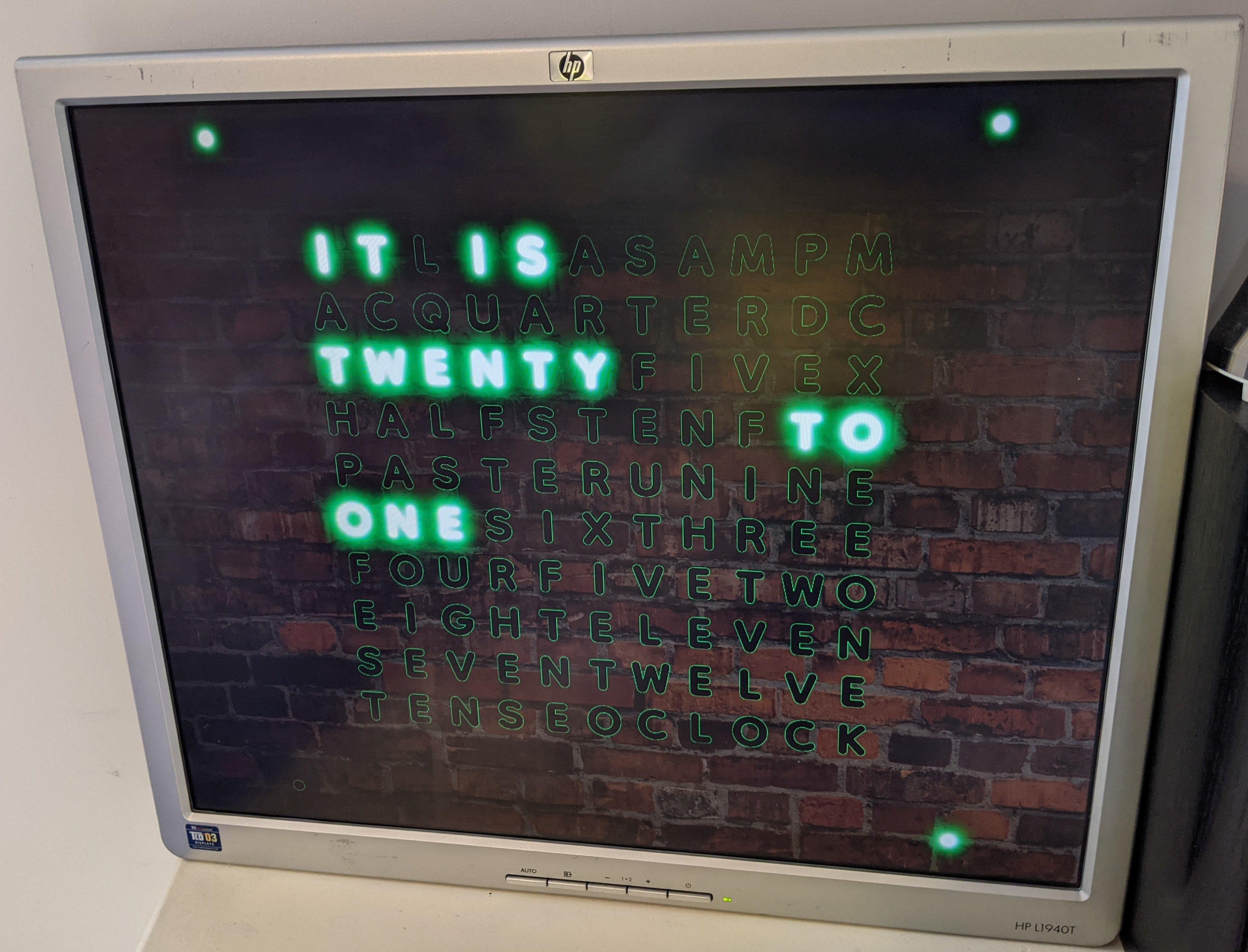Make your own text clock
Things you will need:
A Raspberry Pi
At least a Pi 3 A+. A tried it with a Zero, but it doesn't have enough grunt to handle the CSS animations. Anything beefier than a Model 3A+ would obviously work too, but the 3A+ is at the sweet spot for power-consumption versus performance (and price).
A 4x3 monitor
Ideally you'd want a fully-square one, but these seem to be few and far between - a search on eBay for "square monitor" yields a whole load of 4x3s claiming to be square, but 4x3 is close enough.
A cable
HDMI to whatever's on the monitor. The Model A has a full-size HDMI port, the Pi 4 has micro-HDMI, and the Zero has mini-HDMI. The monitor I got has a DVI port, and such cables are easy to come by.
Install it
This was all done on a pristine install of Raspberry Pi OS Lite (i.e. no
desktop) via the Raspberry
Pi Imager. As of this writing (2021-12-06) you should use the
Buster (Debian 10) distribution, which is tagged
(Legacy) in the Imager - there's a bug that stops
Chromium from starting properly in Bullseye (Debian
11).
Presuming you can SSH into the Pi:
(optionally) change the hostname:
sudo raspi-config nonint do_hostname jlock
sudo reboot
Once you've done this you should be able to get to the Pi with
ssh pi@jlock.local
Install Git
Git isn't installed out-of-the-box, so:
sudo apt -y update && sudo apt install -y git
Clone this repo
git clone https://github.com/pikesley/jlock
cd jlock
And configure everything
./configure
make
This will install it all, and then reboot into a running clock.

There should be a control interface available at http://jlock.local/controller/ from which you can select from the available clock designs and languages.
Keeping it updated
jlock runs a cronjob
at 03:00 every morning to discover and apply updates to main. It
does this via git reset --hard origin/main so any local
changes will be blatted.
Development
This was all developed on a podman container. To run it:
git clone https://github.com/pikesley/jlock
cd jlock
./configure
make build
make run
The container starts redis and nginx when you
connect to it, so it should be running at http://localhost:8080/. If you start the
controller
make controller
then there should be a control interface at http://localhost:8000/controller/. Note that this interface is designed to run on a phone and the layout is not responsive, so you might want to open the inspector and set it to emulate a phone.
Tests
Install the node dev dependencies
npm install
and then run the tests (and the linters):
make
Designs
I wrote about my massively over-engineered design system here. To actually get the designs building, you'll need to get another connection to the container:
make exec
then start Sass:
make sass
(and there are also some Sass tests).
Languages
jlock supports multiple languages, I wrote about how to implement a new one here
Push changes to the Pi
As long as PIHOST in Makefile.common
resolves to the address of your Pi, you should be able to push new code to it
with:
make push-code
On the Pi, you can force the browser to reload with
DISPLAY=:0 xdotool key F5
Notes
- This was developed specifically on and for Chrome/Chromium. It works OK on Firefox and Safari, and it makes no sense at all on a portrait-orientated phone or tablet, but it was built to work as a kiosk app running on a Pi, which it does very well.
- For more about running a Pi in Kiosk Mode, see the
configure-shelltarget in this Makefile. - There are some incredible people doing some amazing CSS text trickery.
- This owes a great debt to Carson Farmer's text-based clock, written in d3.js.
- Any similarity to a clock you can actually buy for thousands of pounds is entirely coincidental.